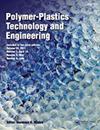增强石墨烯纳米片热塑性共混物热传感器的研制
Q2 Materials Science
引用次数: 5
摘要
碳同素异形体聚合物复合材料在各种工程应用中具有重要意义。我们展示了通过增强石墨烯纳米片成功改性聚丙烯腈/聚氯乙烯共混物。原子力显微镜证实,由于石墨烯的负载,改性共混物的表面出现了部分不混溶的聚合物体系的痕迹。使用阻抗分析仪进行宽带频率(50-35 MHz)的温度(40-150°C)相位角(Ɵ)测量。结果表明,相角随温度的变化而减小。该研究对工程和医疗用热传感器的开发具有重要的指导意义。图形抽象本文章由计算机程序翻译,如有差异,请以英文原文为准。
Development of Thermal Sensor by Reinforced Graphene Nanoplatelets Thermoplastic Blends
ABSTRACT Polymer composites made of carbon allotropes were highly crucial for various engineering applications. We demonstrated the successful modification of polyacrilonitrile/polyvinylfloride blends by reinforced graphene nanoplatelets. The atomic force microscopy confirms the partial immiscible traces of polymer systems with asperities on the surface of the modified blends due to loading of graphene. The phase angle (Ɵ) measurement across the temperature (40–150°C) with the broadband frequency (50–35 MHz) is performed using the impedance analyzer. The results demonstrated the decrease in phase angle as a function of temperature. This investigation is highly suitable for the development of thermal sensor for engineering and health applications. GRAPHICAL ABSTRACT
求助全文
通过发布文献求助,成功后即可免费获取论文全文。
去求助
来源期刊

Polymer-Plastics Technology and Engineering
工程技术-高分子科学
CiteScore
1.71
自引率
0.00%
发文量
0
审稿时长
4 months
 求助内容:
求助内容: 应助结果提醒方式:
应助结果提醒方式:


